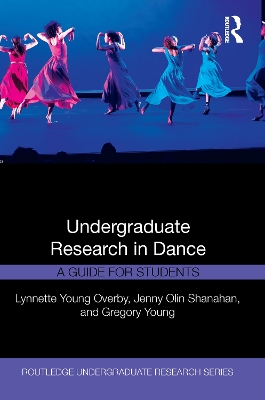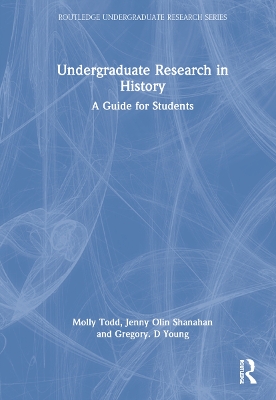Routledge Undergraduate Research
5 total works
Undergraduate Research in Film
by Lucia Ricciardelli, Jenny Olin Shanahan, and Gregory Young
Undergraduate Research in Film: A Guide for Students supplies tools for building research skills, with examples of undergraduate research activities and case studies on projects in the various areas in the study of film, film theory, film production, history of film, and interdisciplinary projects. Professors and students can use it as a text and/or a reference book. Essentially, what makes this volume unique is that it brings together examples of film projects and film studies courses within the framework of research skills.
Following an overview chapter, the next seven chapters cover research skills including writing literature reviews, choosing topics and formulating questions,working with human subjects, collecting and analyzing data, citing sources and disseminating results. A wide variety of sub-disciplines follow in chapters 9-16 with sample project ideas from each, as well as undergraduate research conference abstracts. The final chapter is an annotated guide to online resources. All chapters begin with inspiring quotations and end with relevant discussion questions.
Undergraduate Research in Music: A Guide for Students supplies tools for scaffolding research skills, with examples of undergraduate research activities and case studies on projects in the various areas of music study. Undergraduate research has become a common degree requirement in some disciplines and is growing rapidly. Many undergraduate activities in music have components that could be combined into compelling undergraduate research projects, either in the required curriculum, as part of existing courses, or in capstone courses centered on undergraduate research.
The book begins with an overview chapter, followed by the seven chapters on research skills, including literature reviews, choosing topics, formulating questions, citing sources, disseminating results, and working with data and human subjects. A wide variety of musical subdisciplines follow in Chapters 9–18, with sample project ideas from each, as well as undergraduate research conference abstracts. The final chapter is an annotated guide to online resources that students can access and readily operate. Each chapter opens with inspiring quotations, and wraps up with applicable discussion questions.
Professors and students can use Undergraduate Research in Music: A Guide for Students as a text or a reference book in any course that has a significant opportunity for the creation of knowledge or art, within the discipline of music or in connecting music with other disciplines.
Undergraduate Research in Dance
by Lynnette Young Overby, Jenny Olin Shanahan, and Gregory Young
Undergraduate Research in Dance: A Guide for Students supplies tools for scaffolding research skills alongside examples of undergraduate research in dance scholarship. Dance can be studied as an expressive embodied art form with physical, cognitive, and affective domains, and as an integral part of society, history, and vast areas of interdisciplinary content. To this end, the guidance provided by this book will equip future dance professionals with the means to move the field of dance forward.
Chapters 1–9 guide students through the fundamentals of research methods, providing a foundation to help students get started in understanding research protocols and processes. Students will learn skills such as how to choose a research topic, refine research questions, conduct literature reviews, cite sources, synthesize and analyze data, develop conclusions and results, and present their findings. Chapters 10–19 detail forms of undergraduate research in a rich diversity of fields within dance that are taught in many collegiate dance programs including dance therapy, history, science, psychology, education, and technology, in addition to public scholarship, choreography, and interdisciplinary topics. The book also includes a final chapter which provides annotated online resources, and many of its chapters are supported by examples of abstracts of capstone projects, senior theses, and conference presentations by undergraduate researchers across the United States.
Suitable for both professors and students, Undergraduate Research in Dance is an ideal reference book for any course that has a significant opportunity for the creation of new knowledge, or as an essential interdisciplinary connection between dance and other disciplines.
Undergraduate Research in Architecture
by D. Andrew Vernooy, Jenny Olin Shanahan, and Gregory Young
Undergraduate Research in Architecture: A Guide for Students supplies tools for scaffolding research skills, with examples of undergraduate research activities and case studies on projects in the various areas of architecture study. Undergraduate research has become a common degree requirement in some disciplines and is growing rapidly. Many undergraduate activities in music have components that could be combined into compelling undergraduate research projects, either in the required curriculum, as part of existing courses, or in capstone courses centered on undergraduate research.
Following an overview chapter, the next seven chapters cover research skills including literature reviews, choosing topics, formulating questions, citing sources, disseminating results, and working with data and human subjects. A wide variety of sub-disciplines follow in the remaining chapters, with sample project ideas from each as well as undergraduate research conference abstracts. The final chapter is an annotated guide to online resources. Included are some inspirational quotations concerning architecture's commitment to research, and some examples of professional research that support the focus of the chapter. All chapters end with relevant questions for discussion.
Undergraduate Research in History
by Molly Todd, Jenny Olin Shanahan, and Gregory D Young
Undergraduate Research in History offers a blend of theory and practice for undergraduate researchers in history, relevant to new routines of the digital age. Explaining how research conducted by undergraduate students fits into the broader contexts of the discipline of history and the expanding realm of undergraduate research, this book presents the major phases of substantive research projects, and offers practical advice for work in specific historical areas as well as in interdisciplinary projects. The volume addresses key issues facing researchers, including finding relevant sources, funding research projects, and sharing results with diverse audiences. Supported by dozens of examples of real-world undergraduate research projects, this book is an indispensable reference for any student embarking on historical research and for professors guiding and collaborating with undergraduate researchers.




